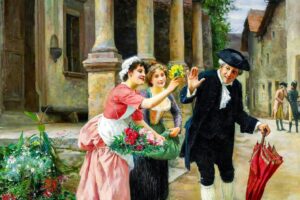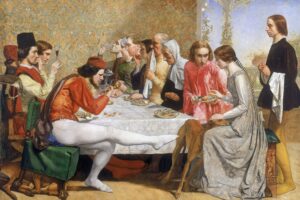Table of Contents
Overview
Winnowing (c.1880) by John Roddam Spencer Stanhope presents a luminous scene of rural labor elevated to allegory. Three peasants — a young man raking grain, a girl pouring corn through a sieve, and another kneeling to gather the golden harvest — work together in quiet rhythm before a stone mill and sunlit landscape. Their gestures echo ancient rituals of separation, where grain is sifted from chaff, the useful from the discarded.
Stanhope (1829–1908), a second-generation Pre-Raphaelite, infused everyday subjects with spiritual and symbolic meaning. Influenced by Italian Renaissance art, he treated labor with dignity, transforming ordinary work into a vision of balance between humanity and the natural world.
Exhibited during the late 19th century, Winnowing was admired for its decorative clarity and symbolic resonance. Today, it endures as both a record of timeless agricultural practice and a poetic metaphor of renewal, order, and the harvest of life.
About the Artist
John Roddam Spencer Stanhope (1829–1908) was an English painter aligned with the later Pre-Raphaelite circle. Living much of his life in Florence, he absorbed Renaissance harmony and symbolism, blending it with the Pre-Raphaelite devotion to detail. His works often explored biblical, allegorical, and rural themes, distinguished by jewel-like color and rhythmic design. Though quieter in fame than Rossetti or Millais, Stanhope’s art bridges realism with allegory in uniquely lyrical ways.
The Story Behind the Painting
The Agricultural Ritual
Winnowing is an ancient process: tossing grain into the air or sifting it through a sieve so the wind separates kernel from husk. This simple act, repeated across centuries, embodies human cooperation with nature’s forces. Stanhope’s painting celebrates this timeless tradition.
Symbolism of Separation
For Victorians, winnowing carried moral and spiritual resonance. It symbolized discernment — separating truth from falsehood, essence from excess, the eternal from the fleeting. In Stanhope’s hands, the act of labor becomes allegory.
A Pre-Raphaelite Approach to Labor
Unlike many artists of his generation who romanticized rural life, Stanhope imbued it with dignity and solemnity. He shows the workers not as anonymous peasants but as figures of balance and harmony, their gestures woven into a larger spiritual rhythm.
Composition and Subjects
The Young Man with the Rake
At the left, a barefoot man leans forward with muscular focus, raking the grain across the stone floor. His posture conveys energy and grounding, anchoring the group’s labor.
The Girl with the Sieve
At the center, a young woman lifts a wooden sieve above her head, allowing grain to cascade down like golden rain. Her upward movement contrasts with the man’s downward gesture, creating dynamic balance.
The Kneeling Worker
To the right, another girl crouches to gather the scattered harvest. Draped in a headscarf of orange and blue, she embodies patience, humility, and care in preserving what falls.
The Mill and Landscape
Behind them rises a rustic stone mill, with water flowing in a trough, and beyond, sunlit hills and open sky. The setting situates the figures in both timeless labor and eternal nature.
Art Style and Techniques
Jewel-like Clarity
Stanhope paints with jewel-like tones — deep reds, clear blues, sunlit gold — echoing medieval frescoes and stained glass. Every detail, from the grain to the folds of fabric, shimmers with precision.
Renaissance Influence
Living in Florence, Stanhope absorbed Renaissance compositional harmony. The figures are arranged in triangular balance, their gestures echoing fresco cycles of labor and virtue.
Pre-Raphaelite Symbolism
Beyond realism, the scene becomes allegorical. The golden grain symbolizes abundance and spiritual truth; the act of sifting reflects discernment, the eternal lesson of separating substance from shadow.
Legacy and Reflection
Reception
Victorian audiences admired the painting for its solemn dignity and decorative beauty. It offered a vision of labor not as toil but as ritual, a moment where ordinary work becomes symbolic of eternal truths.
Lasting Significance
Today, Winnowing is valued for its fusion of realism and allegory. It bridges agricultural tradition with Pre-Raphaelite symbolism, embodying the dignity of human work in harmony with nature.
Featured in Our Collection
Winnowing is proudly featured in our Genre Painting Spot-the-Difference Puzzle Flipbook. Its detailed depiction of rural labor — from scattered grain to flowing water — makes it an engaging puzzle subject. By exploring differences within Stanhope’s intricate composition, you sharpen observation while appreciating the Pre-Raphaelite respect for labor, symbolism, and timeless tradition.
The Golden Harvest
Three figures labor together, grain falling like golden rain, gestures bound in harmony. In Winnowing, Stanhope transforms simple work into vision — a painting where human hands, nature’s gifts, and eternal meaning intertwine.



